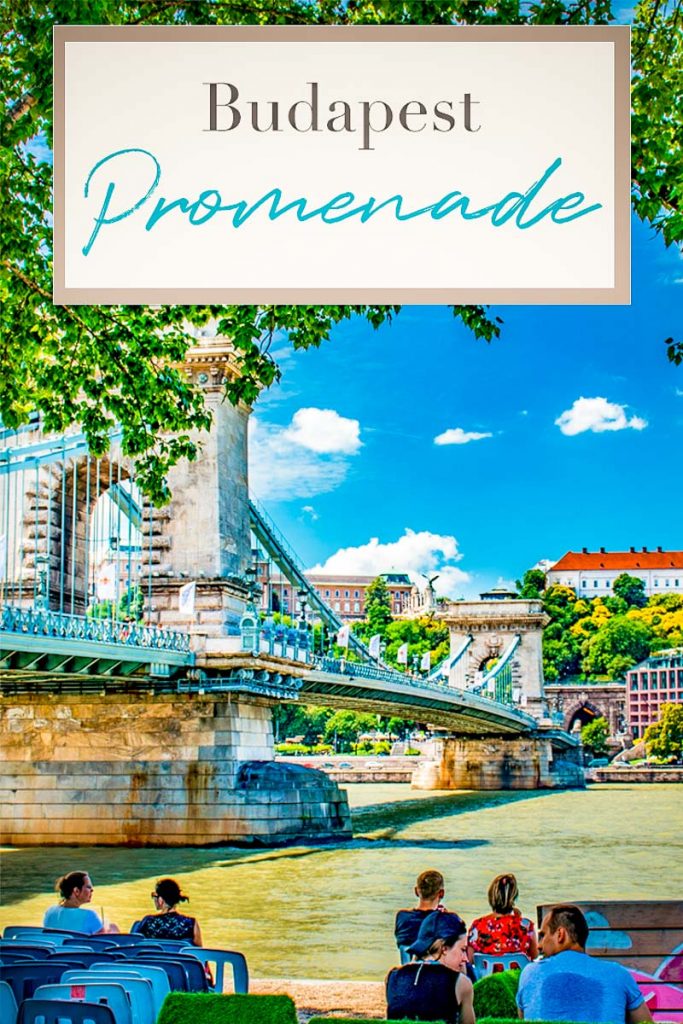The Danube Promenade (Dunakorzó) stretches between the Elizabeth Bridge and the Chain Bridge in Pest along the banks of the Danube. Back in the 19th century the Promenade was home to several famous hotels and their cafés, with their spectacular view of the Danube and the Buda Castle, they were very popular. Even today, the Promenade is one of the main attractions of Budapest.
The promenade is one of the most beautiful parts of Budapest with a fantastic view of the Buda side and the World Heritage Danube panorama.
Its cast iron railings and lamps standing on the decorative paving are unique.

Today five-star hotels – like Gresham Palace, InterContinental and Marriott – border the promenade, giving their guests superb views.
The promenade is one of the best places to for a stroll in Budapest, both day and night.
Take either a walk, or choose the tram or a bike, it’ll definitely be a cool adventure to explore the Danube bank.
Looking at the spectacular view of the bridges, the churches on the Pest side, the hills of Buda side, or the reflections in the water, it’s no wonder why it’s a World Heritage.
Budapest lives together with the Danube.
The Danube is the second longest river in Europe.
At the Chain Bridge it is 350 meters wide and it is its widest section in Budapest. The narrowest is at the Elisabeth Bridge with 280 metres. The water depth varies between 3 and 10 meters. It is shallower where the river is wider.
The height of the water is calculated from the lowest measured water level and not from the riverbed.
Its average speed is 0.5 meters per second.
Until the 1800s when Count István Széchenyi initiated the regulation of the river, a significant part of Budapest was floodplain.
Unfortunately the water of the Danube in Budapest has not been suitable for bathing since the 1950s.
The Danube has always been a scene for transport, commerce and industry. The river plays a vital role in all of the countries it crosses.
There are a lot of cargo ships on the river carrying a wide range of products from grains to cars.

The Danube’s banks were the scenes of many feasts and tragedies of Hungarian history.
The houses lining the river are marked with proof of their history. Most of the buildings were built in the late 1800s and early 1900s.
Significant number of these apartment-houses have classic inner patios. Especially on the Buda side, their main doors are not necessarily open to the river. The reason is simple: when they were built the primary function of the river was commercial, not recreational plus it gave some kind of protection against floods, too.
Along to river bank, all kinds of buildings can be seen. They were built in different eras, style and their functions are numerous.
When you have a look at the Danube from its bank today, it is hard to imagine that 200 years ago the river was still flowing where you stand.
Main attractions along the Danube promenade
The unique sight of the bridges, the towers of the churches, the hills of Buda and the reflection of the evening lights are rightly became members of the World Heritage Sites.
Palace of the Ministry of Justice


This huge, beautiful building houses the Museum of Ethnography until recently. In the near future the Curia is going to move back into it.
Ministry of Agriculture
Was built between 1885-1887.
On 25 October 1956, the third day of the revolution the people protested for an independent, democratic Hungary in front of the Parliament. They spoke to the soviet soldiers in the tanks that were lined up. They tried to make them understand that they were people fighting for the independence of Hungary and not fascists.
Suddenly shots were fired at the crowd from the top of the Ministry of Agriculture and the surrounding buildings. It is still unknown exactly who the shooters were.
There are bronze bullets in the wall of the building as memorial for the victims of the 1956 shooting.
Parliament

The Hungarian Parliament is one of the biggest stars when it comes to the most photographed and visited buildings of Hungary. It is familiar even for those who have not set their foot in the city. Based on reviews on TripAdvisor, it ranks among the top 25 landmarks of the world.
Shoes on the Danube Embarkment

The monument honours those who were ordered to take off their shoes, and were shot at the edge of the Danube.
Hungarian Academy of Sciences
It main purpose is to spread the achievements of science, to support researches.
There are six statues on its main facade, representing the six faculties: History, sciences, law, mathematics, languages, philosophy.
The figures looking towards the Danube are symbols of archaeology, poetry, astronomy and politics.
There is a bronze relief on the side that faces Akadémia street which shows István Széchenyi offering on year of his income to finance the founding of the Academy in 1825.
Roosevelt Square

Grasham palace

The building was erected by the British Gresham Life Insurance Company.
After its opening in 1907 the Palace was a huge success and its coffeehouse attracted people like a magnet.
It is an outstanding building of the Hungarian secessionist architecture. Its wall tiles, walling and flooring were designed and made by the Zsolnay factory.
It was renovated between 1999 and 2004 and now it is the most beautiful and luxurious hotel in Budapest.
Story time
The Danube promenade has been lined with elegant row of hotels, fashionable summer restaurants and terraces since the 1800s. Several hotels were built here such as Carlton, Bristol, Hungaria, Ritz. They all were the same high as Thonet-House on the corner of Vigadó Square. The Promenade took shape in front of them.
There were nine coffeehouses right next to each other, their terraces joined together, all facing the Danube. Especially in the evenings the luminous terraces were inviting and cosmopolitan. A bit further from the lit coffeehouses sit and walked those who could not afford the high prices of the fashionable cafes.
The promenade was the place where ladies showed of their dresses and men were staring them. Everybody showed up here who wanted to see and be seen.
Sándor Buchwald became known throughout Budapest and a true legend as in 1874 he put rows of chairs to the promenade for rent. Only those who bought tickets were allowed to sit down. For ladies it was highly advisable to avoid these chairs because men were sitting there to flirt and censoriously discuss the women’s appearance.
Buchwald employed old women to sell the tickets and he was regularly checked their work from the cover of trees. He was constantly on the promenade from spring to fall.
Only his family was happy that he was not spending too much time at home, I guess.
Vigadó square

The building that originally stood here was the place where Lajos Kossuth call to arms in 1848. In 1849 the building was shot to ruins by Austrian artillerymen shooting from Buda.
The building that stands here today is one of the most iconic buildings of the embarkment.
Today it is a cultural centre. The view from its roof terrace is really nice.
Little Princess statue

Its sculptor, László Márton was inspired by his own 5 year of daughter, Évi who loved to play in Tabán (a hillside almost opposite the statue, a bit to the left) dressed as a princess, wearing paper crown.
The replica of this statue stands in front of the Tokyo Metropolitan Art Space cultural center.
Girl with a dog statue

An another genre statue – by Dávid Raffay – that makes the Danube bank more friendly.
Narrowest house of Budapest
Along the river bank there a buildings that are much slimmer than the others.
The narrowest is called Mandl house and stands on the Buda side near Döbrentei Square, almost right opposite the Girls with a dog statue, on the Buda side.
It width is only 5.5 meters on the riverfront and 6,2 meters from its other side. It is under protection since the 1960s and later the whole riverbank with all of its buildings became protected by UNESCO.
The house is best seen from the Pest side.

Marriott Hotel
This hotel was the first that was built after the war. It has a beautiful view of the Danube from every room.
Shakespeare Memorial

The statue shows him as an actor. The marble table under the statue is dedicated to the names of those translators, authors, writers, actors etc who played big role in the promotion of the Shakespearean culture.
Március 15 Square
This square is right before Elisabeth Bridge.
Here stands the Inner City Parish Church that is one of the oldest buildings of Pest. It was originally built about 1,000 years ago on the walls of Contra Aquincum, a town at the Danube in the Roman era.
Contra Aquincum
Well before the arrival of Hungarians western part of today’s Hungary was under the rule of the Roman Empire. It was called the prince of Pannonia and the Danube was its western border. The borders were protected by forts, watch towers.
The remains of Contra Aquincum can be seen on the street where the outline of the former fort is market by stone slabs.
Elisabeth Bridge

The bridge that stood here originally was built in 1903 and was exploded by the German army.
Somehow only the south chamber on the Buda side exploded from the four.
The chain could not held the weight of the bridge and slewed in south direction, pulling the rest of the bridge with itself.
The chain on the north side injured but did not break.
The bridgehead on the Pest side remained standing as a memento for the destruction of the war.
Elisabeth Bridge was the last one to be restored.
The new bridge is 10 meter wider as the original was because the sidewalk is now outside of the chains.
Fővám Square
The square was named after the Customs House (in Hungarian Fővámház). A marketplace formed here, where fishermen could row their boats from the Danube through a canal into the Market Hall.
Central Market Hall

This yellow and red brick building – which is the biggest market is Budapest with its 10.000 square meters – was built according the designs of Same Pecz in 1897.
Its roof is covered by Zsolnay tiles. It has an enormous iron roofing. It is the biggest market in Budapest and possibly the most beautiful in Europe.
Bálna

Behind the Market Hall, on the Danube promenade stands a building that can remind us to a whale. It is indeed called Bálna, which means whale in Hungarian.
Originally four halls of the Public Warehouses stood here. They served the trading pathway in Austro-Hungaian times where most Hungarian grain was transported by boats.
Between 2009-2013 two of the four warehouses were connected with a whale shaped glass and metal shell.
It has viewpoints inside and in the whale’s tail that give us a unique panorama.
The Bálna serves as a cultural and commercial centre with several restaurants and pubs.
From here if you continued your walk to the south, you would arrive to the Millennium City Centre but that is subject of an another blog post.
Share this post with your friends! 🙂
Pin Now, Read Later. Save This Post on Pinterest.

You might be interested in these posts, too:


